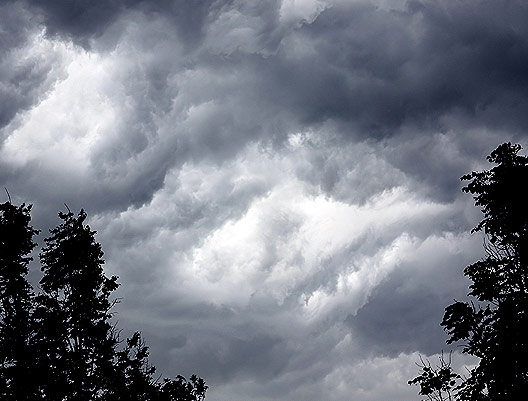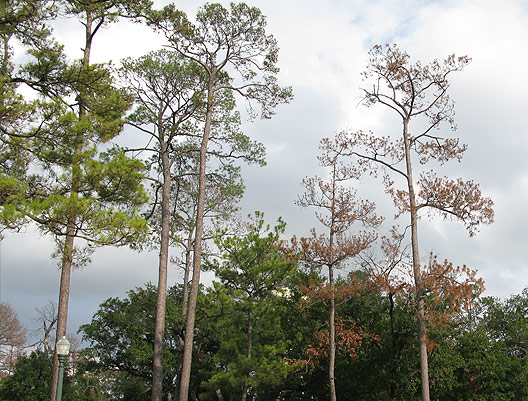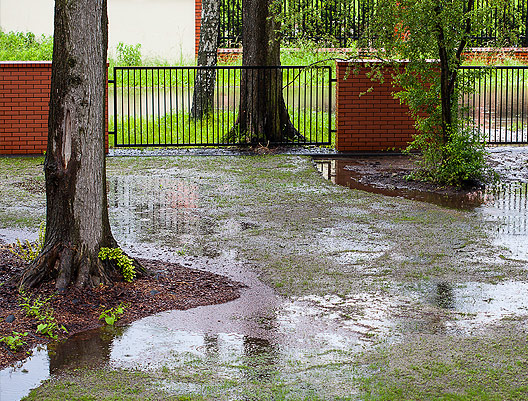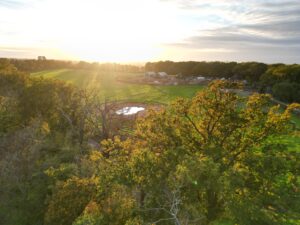Extreme weather events happen in nearly every geography, leaving a lasting impact on the trees and shrubs in a landscape. Once the rain or wind has stopped, the snow has melted or the drought has passed, it takes time for plants to recover. During this time, trees are under a tremendous amount of stress.
Aesthetically, depending on the situation, foliage may become discolored or wilted and branch dieback can occur. Trees may incur damage to the branches or crown. More seriously, structural damage – sometimes visible (a hanging branch or crack) and sometimes not (root damage) – is commonplace. Stress from weather conditions also increases the likelihood of infestation from harmful insects and disease.
In a managed landscape, it’s important to monitor trees closely after severe weather. An inspection following the weather event will uncover immediate damage, but some symptoms may not appear for months, or even years.
Learn how the conditions your area experiences can impact your trees and shrubs and how you can aid in the recovery process:
Storm Damage

Damaged wood, cracks, and exposed wood resulting from injuries like loss of branches serve as an entry point for insects and disease. The larger the wound is in relation to the size of the limb, the less likely it is to heal, posing greater risk. However, even small broken limbs increase the probability of secondary invaders.
Crown loss, when branches are broken off, severely bent or lost from the tree, is another serious concern. Typically, if more than 50% of the top of a tree is destroyed during a storm, mortality will occur within a few years. Trees with less crown damage have a good chance at recovery, but the aesthetic impact may still be severe. The tree may look unbalanced or misshapen, which can be particularly noticeable in a well-maintained landscape.
Helping Trees Recover from Storms
- Prune hanging branches, damaged or dead wood
- Schedule crown restoration to reestablish desirable form and strong structure over time; avoid over-pruning immediately after a storm as this can cause further injury
- Inspect for root damage, especially on leaning trees or those where the root flare is not visible
- Monitor for signs of pests and disease
Drought

When soils remain dry, fine feeder roots in the upper soil surface are also adversely impacted. These roots, essential for transporting water and nutrients, begin to die. The root system is unable to support foliage and dieback occurs. Even when rain returns, the tree can’t take full advantage due to loss of roots.
Drought-stressed trees have difficulty wounds, making them an easy target for disease and opportunistic insects.
Helping Trees Recover from Drought
- Irrigate trees and shrubs deeply as soon as possible during summer and autumn
- Conserve moisture and improve the root environment by applying a layer of organic mulch around plantings
- in autumn or spring following drought, but only once soils are recharged by rainfall; provides little benefit when water is the limiting growth factor
- Improve your tree’s ability to tolerate drought stress with the application of potassium phosphite
- Monitor for pest infestations, particularly borers, bark beetles, root rot and stem canker diseases
Flooding

Flooding can also impact the acidity or alkalinity of the soil. Some species tolerate variance in pH, but others may struggle to survive when the soil composition is altered.
While physical injury may occur during flooding, the main concern is damage to the roots and dieback of the root system. When the root system is damaged, the tree as a whole will suffer proportionately. Structural stability will also be since roots serve as an “anchor” to keep the tree upright.
Helping Trees Recover from Flood Damage
- Improve drainage and relieve compacted soil using air spade technology
- Perform soil analysis to determine pH and soil conditions; apply based on results
- Once flooding has subsided, apply a thin layer of organic mulch from just off the trunk to the outer dripline
- Apply potassium phosphite to improve disease resistance



